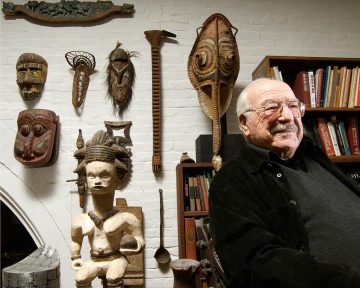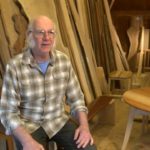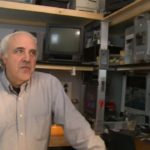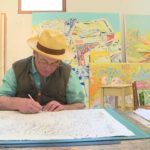
NetWorks Rhode Island and the Chazan Collection Exhibition, WaterFire Arts Center (2024) Bio:
Walter Feldman was born in 1925 in Lynn Massachusetts. His parents were immigrants from Eastern Europe and Feldman grew up in Chelsea “… a Russian-Polish-Jewish community surrounded by Irish”. His father ran a small grocery store and moonlighted as a tailor, while his mother stitched shoes in a factory. While Feldman’s parents hoped he would enter one of the practical professions like law, they appeased his interest in art as a youngster by allowing him to take art classes on Saturday afternoon at the Boston Museum of Fine Arts. Reminiscing in later life about these painting classes, Feldman said “I got fifteen cents for lunch and had a hot dog and orangeade every week. I loved it”. After high school, Feldman was admitted as a student at the Yale School of the Fine Arts in 1942. But like so many young men of his generation, Feldman’s education was interrupted after one semester by his service in World War II.
From 1943 through 1946, Feldman served in the 330th Infantry Regiment of the 83rd Infantry Division, a unit that saw significant combat in the European theatre. During his tour of duty Feldman was awarded 4 battle stars, the Purple Heart and the combat infantry badge and reached the rank of 2nd Lieutenant. His service included action in the Allied Forces defense of the Ardennes forest during the German counter-offensive action known as the Battle of the Bulge. On January 6th, 1945, while under heavy mortar and artillery fire, Feldman sustained shrapnel wounds to his lower back and lay strapped on the top of an Army jeep for five hours awaiting evacuation and treatment. His near death and harrowing rescue experiences left impressions that would manifest in the artist’s work over the decades, as well as leaving him with a life-long injury. Told he would likely never walk again while recuperating, he overcame the pain and injury turning to painting as a form of healing. “Through the pain I learned how to paint too. Pain and painting, I learned the strange verbal connection”
World War II themes played a prominent role in Feldman’s art throughout the decades. A study for The Soldier is perhaps the most poignant early example of Feldman’s sobering war experience. It is a macabre image of a skeleton-faced soldier, completed in 1946 when he returned from service.
“I had many moving experiences during the war. One of them happened at a time when we were having two meals a day during combat. We were in line getting food, and we were pleased because we had cold rations for weeks. After I got my food, I started to walk down the steps of a nearby quarry to find a place to sit, and there was a dead German soldier with just his toes sticking out of his boot. Dead and cold. That was the memory I had when I did this painting tempura on cardboard.
Feldman returned from war a mature, thoughtful, and spiritual artist at a tender age and re-enrolling at Yale in the Fall of 1946, he completed his BFA in 1950. Feldman was awarded the Alice Kimball English Traveling Fellowship and spent a few months after graduation traveling in France and Italy and furthering his exposure to past masters and modern European artists. He returned to Yale as a graduate student, where his teachers included Willem de Kooning and Josef Albers, and received an MFA in 1951. Albers and de Kooning were big influences on his art. As an undergraduate art student (1946-1950), Feldman worked on mastering technical painting skills in a realism style. The work, The Mother, is a “memory portrait” from this period. “The painting was done after knowing and meeting the mother of Stuart Davis. A buddy and I rented a studio in a big complex in Gloucester, Massachusetts, and a little old lady was there, too, making small sculptures. It turned out to be Stuart Davis’s mother.”
But there were many competing art currents about in the early 1950s—with European modernists like Cezanne, Surrealists like Dali, Cubists like Braque, Abstract Expressionists like Pollock and de Kooning and Geometric Abstractionists like Albers. Feldman took note of them all as he was developing his own style. Modernist ideas became the fabric of Feldman’s daily life. Feldman joined the Yale faculty as an Instructor of Painting for the next two years, before accepting a position of Assistant Professor of Art at Brown University in Providence, RI in 1953.
The decade of the 1950s, saw the young artist compete and establish himself in New York City, the capital of the burgeoning world of contemporary art. He entered works that were accepted to multiple juried exhibitions. In 1952, Feldman achieved his first major professional critical success when received the print prize at the Metropolitan Museum of Art for his woodcut The Final Agony. The Final Agony, a crucifixion scene, was submitted with 7,109 other artist prints to this Metropolitan exhibition. Only 8% of the entrants were selected for exhibition and just 6 print prize winners awarded. This was a major achievement for the artist. The print is now in the collections of the Metropolitan as well as Yale University, which also acquired the carved wood block.
Feldman excelled in the medium of woodcut. Beginning in 1952, his woodcuts were selected for exhibition in over 23 museum print shows. His talent was widely recognized with Feldman garnering multiple awards including the Purchase Prize from Youngstown University’s exhibition College Prints (1956); Tonner Prize of the American Color Print Society (1958); Childe Hassam Purchase Award from the National Academy of Design (1959), and Honorable Mention in Seattle Art Museum’s Northwest Printmakers competition (1953, 1955). The woodcut medium would remain a staple in Feldman’s body of work. Throughout his long career, his printmaking was critically acclaimed and later fueled his interest in making unique art books in the 1990s.
In 1953, Feldman came to Brown University in Providence embarking on a five-decade teaching career and life-long association with the institution. That year marked the artist’s first solo exhibition at the Artists’ Gallery on Lexington Avenue in New York City, and the inclusion of his paintings in a group show at New York’s prestigious Kraushaar Galleries. The exhibited works demonstrated Feldman’s journey to absorb modernism and his stylist drift towards abstraction. The Artists’ Gallery was a venue to expose promising young artists to the public. Feldman’s show introduced him to the New York art scene warmly. Art Critic Dore Aston of Art Digest reviewed Feldman’s 1953 exhibit and wrote “In his first one-man show, this young painter hovers between French cubism and German expressionist, using the flat decorative shapes of the former and the vigorous distorted figures of the latter. The two languages are agreeably synthesized in smaller still-lifes”. Critic Howard Devree of the New York Times wrote “the paintings exemplify the main concern of many modern painters—the reconciliation of subject matter with idiosyncratic and abstract painting language”. He concluded the show was “a remarkably mature first one-man exhibition of paintings…”
The year 1957 was a milestone period for the artist. Feldman studied mosaics and stained glass in Italy on a Senior Fulbright Fellowship for the year. Feldman spent much of that time as an apprentice to an Italian mosaic master in Rome, but also traveled to Spain, the Middle East, Turkey, and Israel to study various mosaic styles. Feldman’s art flourished during this year. His self-portrait was awarded the gold medal at the Mostra Internazionale in Milan, and this success was followed by a solo exhibition at Milan’s Grattacielo Gallery. His knowledge of mosaics permeated much of his future art with the result that many of his new paintings incorporated an impasto paint technique that gave the canvas a mosaic texture. Feldman’s artistic style was breaking from realism using lush color, collaging onto his canvases and creating a fractured visual space. That same year he received two major commissions: a multicolor woodcut for the International Graphic Arts Society and a series of exterior mosaic pavements for the Temple Beth-El in Providence.
During the 1950s and 1960s, Feldman work was in the midst of the creative maelstrom of modern art. He garnered multiple solo exhibitions at Kraushaar Galleries in New York, as well the Decordova Museum in Massachusetts, the Providence Art Club, the Obelisk Gallery, Pace Gallery, and Kanegis Gallery in Boston, the Mexican- American Institute in Mexico City and the Institute of Contemporary Arts in London. Akin to de Kooning’s thinking, Feldman never abandoned the natural world for inspiration for his art. His themes included time-honored subject matter like death, war and spiritual redemption. But like the modernists of his day, Feldman sought a new expressive vocabulary for these themes on his canvases. Poet James Schevill wrote of Feldman in a 1978 essay, “During the 1950s, although his work grew much freer, he hovered between the influence of the Abstract-Expressionists and his instinctive desire, from his Jewish, humanistic background, for symbolic subject matter”.
The decade of the 1960s saw Feldman continue to produce as a tireless painter, printmaker and mosaicist. Feldman executed a large exterior mosaic mural for Temple Emanu-El in Providence, and that was followed by a commission to create seven stained glass windows for the Sugarman Memorial Chapel in Providence (1961). He was awarded the George A. and Eliza Gardener Howard Fellowship and spent 1962 painting in Mexico where he absorbed a great deal of the pre-Columbian imagery and culture. In 1968, Feldman designed and painted a 32-panel mural for the new meeting hall of Temple Emanu-el in Providence.
Feldman was promoted to Professor of Art at Brown University in 1961 and was a beloved teacher at that institution for over 50 years while continuing to create and exhibit his art widely in multiple media—painting, printmaking, sculpture and mosaics.
From 1985 on, Feldman has divided his time between painting and as a designer and publisher of artists’ book under the Ziggurat press imprint. Feldman was the founder of the Ziggurat Press in Providence, which quickly became known as the most innovative and individualistic fine art presses in the country. His works are in over 150 public collections including the Metropolitan Museum of Art and the Museum of Modern Art in New York, the Holocaust Museum and the Smithsonian Institution, Archives of American Art in Washington, DC, Los Angeles County Museum, and the Albert and Victoria Museum.
Feldman retired from teaching at Brown University in 2007, but he kept creating art and publishing prints and books up until his death in Providence in 2017. Upon his passing he created the Walter S. Feldman Trust for Artwork at Brown University to maintain his works and provide funds for the institution.
Original NetWorks Catalogue Bio:
When I was a student I attended a lecture by Naum Gabo the painter and sculptor whose philosophy of Constructive Realism had a profound effect on all modern art. He began his remarks by saying, “ It has always been my principle to let my work speak for itself, following the maxim that a work of art does not need to be explained by its author, that it is rather the other way around, it is the author that is explained by his work of art.” In this complex and difficult, world-shattered environment, we can’t make comparisons with norms- but the artist can say- HERE I AM…This is how I see the world..I believe my work reflects the inexpressible -yet is the most effective means of communication between the members of human society.
Source: NetWorks 2008 Catalogue

Oil ink on prepared paper 40 x 28 in.
Credits:
Video: Richard Goulis
Music:
Andante by Carl Friedrich Abel
“Non Piu Andrai” (Le Nozze Di Figaro), “Non Sai Tu” (La Favorita) “Il Lacerato Spirito” (Simone Baccanegra) by Ezio Pinza, Preiser Records 1994
Still Photography:
Edward Huff
Brooke Hammerle
United States National Archives and Records Administration
Brown University Art Slide Library, Norine Duncan Scholarly Resources Librarian, Karen A. Bouchard, Associate Curator
Additional Footage from: “Walter Feldman – Painting With Glass” Amedia Productions, 1999
Executive Producer: Joseph A. Chazan M.D.
Additional Information:
Artist’s website: walterfeldmanartist.com
Highlighting the work of selected artists who have played vital roles in shaping the contemporary visual arts community in Rhode Island. This collection of brief video portraits provides a window into the lives, practices, and cultural contributions of professional artists.



